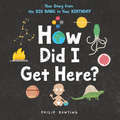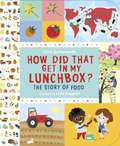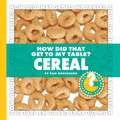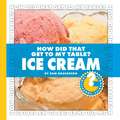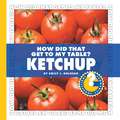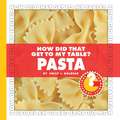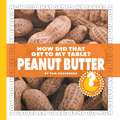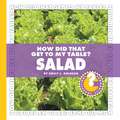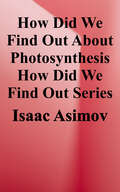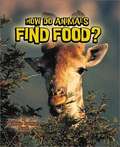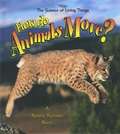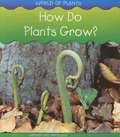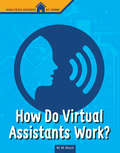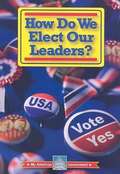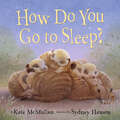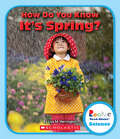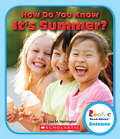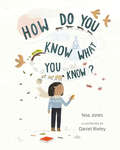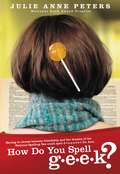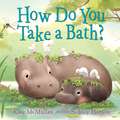- Table View
- List View
How Deep Is the Ocean? (Let's-Read-and-Find-Out Science 2)
by Kathleen Weidner ZoehfeldRead and find out about the deepest part of the ocean in this colorfully illustrated nonfiction picture book.The ocean covers almost three-quarters of the Earth, but how deep does it go? Put on your scuba gear and explore the ocean, from its shallowest waters to its deepest, most mysterious parts. As you dive deeper, you’ll discover glowing animals, strange creatures that don’t need sunlight to survive, and even the largest hunter in the world.With beautiful illustrations and engaging text, How Deep Is the Ocean? will guide young readers into the deepest parts of the ocean. Featuring a find-out-more section with a water-pressure experiment, a lesson in making a sounding line to learn how scientists measure the depth of the ocean, a glossary of new terms, and web research prompts, this book will begin children’s explorations of the deep sea. Both the text and the artwork were vetted for accuracy by Dr. David Gruber, real-life deep sea explorer and professor of biology and environmental science at Baruch College.This is a clear and appealing science book for early elementary age kids, both at home and in the classroom. It's a Level 2 Let's-Read-and-Find-Out, which means the book explores more challenging concepts for children in the primary grades. The 100+ titles in this leading nonfiction series are:hands-on and visualacclaimed and trustedgreat for classroomsTop 10 reasons to love LRFOs:Entertain and educate at the same timeHave appealing, child-centered topicsDevelopmentally appropriate for emerging readersFocused; answering questions instead of using survey approachEmploy engaging picture book quality illustrationsUse simple charts and graphics to improve visual literacy skillsFeature hands-on activities to engage young scientistsMeet national science education standardsWritten/illustrated by award-winning authors/illustrators & vetted by an expert in the fieldOver 130 titles in print, meeting a wide range of kids' scientific interestsBooks in this series support the Common Core Learning Standards, Next Generation Science Standards, and the Science, Technology, Engineering, and Math (STEM) standards. Let's-Read-and-Find-Out is the winner of the American Association for the Advancement of Science/Subaru Science Books & Films Prize for Outstanding Science Series.
How Did I Get Here?: Your Story from the Big Bang to Your Birthday
by Philip BuntingFrom the Big Bang to your birthday, and (almost) everything in between, this funny and informative book tells your story.You are one of the newest members of a family tree that goes way, way, way back to the very first life on Earth. A lot of incredible things had to happen between the beginning of the universe and today in order to make you. The fact that you (and everyone you know) are here is nothing short of mind-boggling! Read this book to discover how it happened, and prepare to be amazed by the awesomeness of you.This clever, funny, and scientific timeline of the journey of human existence is designed to get young readers asking questions, finding answers, and marveling at the many wonders of our world, from the Big Bang, to evolution, to a brand-new baby, and more.
How Did That Get in My Lunchbox? The Story of Food
by Chris ButterworthFresh retro artwork lures little readers on a tasty trip to farms, dairies, and more. Yum! The best part of a young child's day is often opening a lunchbox and diving in. But how did all that delicious food get there? Who made the bread for the sandwich? What about the cheese inside? Who plucked the fruit? And where did the chocolate in that cookie get its start? From planting wheat to mixing flour into dough, climbing trees to machine-squeezing fruit, picking cocoa pods to stirring a vat of melted bliss, here is a clear, engaging look at the steps involved in producing some common foods. Healthy tips and a peek at basic food groups complete the menu.
How Did That Get to My Table? Cereal (Community Connections)
by Pam RosenbergYoung readers will gain a better understanding on how the breakfast cereal they love ends up on their breakfast table.
How Did That Get to My Table? Ice Cream (Community Connections)
by Pam RosenbergDo you eat food? Do you use electricity? Do you live in a building or go to a school? These are just some of the activities that connect you to other people in your community. Discover the Community Connections we depend on to provide the things we need. Read the How Did That Get to My Table? books to learn about the connections that bring us our food: Cereal, Ice Cream, Ketchup, Orange Juice, Pasta, Peanut Butter, Pumpkin Pie, Salad. Picture descriptions and captions included.
How Did That Get to My Table? Ketchup (Community Connections)
by Emily J. DolbearWith this title, young readers will gain an understanding on how the ketchup they love, is made and how it ends up on their table. Picture captions and descriptions present.
How Did That Get to My Table? Pasta (Community Connections)
by Emily J. DolbearWith this title, young readers will gain an understanding on how the pasta they love, is made and how it ends up on their table. Picture descriptions and captions included.
How Did That Get to My Table? Peanut Butter (Community Connections)
by Pam RosenbergCOMMUNITY CONNECTIONS--HOW DID THAT GET TO MY TABLE? Do you eat food? Do you use electricity? Do you live in a building or go to a school? These are just some of the activities that connect you to other people in your community. Discover the Community Connections we depend on to provide the things we need. Read the How Did That Get to My Table? books to learn about the connections that bring us our food: Cereal, Ice Cream, Ketchup, Orange Juice, Pasta, Peanut Butter, Pumpkin Pie, Salad.
How Did That Get to My Table? Salad (Community Connections)
by Emily J. DolbearYoung readers will gain an understanding on how salad is grown and how it ends up on their table. Picture descriptions added.
How Did We Find Out About Photosynthesis? (How Did We Find Out About…)
by Isaac AsimovTraces the scientific discoveries that led to our understanding of photosynthesis and how this process relates to the food supply, changing ecological balance, and threats to the Earth's atmosphere.
How Do Animals Find Food?
by Bobbie KalmanWith so many species competing for food, animals have developed fascinating methods of finding the food that keeps them fat and happy. How do animals find food? Lets children in on such techniques as pack and solitary hunting, and poisonous animals.
How Do Animals Move?
by Bobbie Kalman Niki WalkerSlithering snakes, jumping kangaroos, flying albatrosses, and swimming salmon--every animal, including humans, has its own unique way of getting around. This beautiful new book explains the how, why, and "are we there yet?" of animals large and small across the globe. Topics include: *how an animal's environment affects its movement *how an animal's skeleton affects its movement *unusual animal movers such as the water-walking basilisk *how a parent helps its young move around
How Do Apples Grow (Lets read-and-find-out Science #Stage 2)
by Betsy MaestroDescribes the life cycle of an apple from its initial appearance as a spring bud to that point in time when it becomes a fully ripe fruit.
How Do Plants Grow? (World Of Plants Ser.)
by Richard Spilsbury Louise SpilsburyLooking inside a seed. We'll look at a cut-open bean seed and talk about the food store and the baby plant and the seed coat. The baby plant in a seed stays safe and warm inside the seed coat until it is ready to start growing, usually in spring when the weather is warm and wet.
How Do Virtual Assistants Work? (High Tech Science at Home)
by M. M. EbochA virtual assistant by any name - Alexa, Siri, whoever - can be a sweet addition to your home. You might use one for simple jobs like playing music or streaming podcasts. And you might use one to communicate with friends and remind you about homework coming due while helping you make your breakfast. Find out how digital assistants work and what the future might hold for this part of a high-tech home.
How Do We Elect Our Leaders? (My American Government)
by William David ThomasIn what ways are the branches of government like a basketball game? How can a school yard game's rules liken themselves to a constitution? Through engaging analogies and introductions, our new government series gets students ready for election 2008. Correlated to the fourth and fifth grade social studies curriculum, My American Government introduces students to how our government works. Students learn about the U.S. Constitution, the branches of government, citizens' basic rights, and how we elect our leaders.
How Do Weather And Climate Affect Our Lives?: Student Activity Guide
by The Smithsonian InstitutionNIMAC-sourced textbook
How Do You Go to Sleep?
by Kate McMullanDiscover how different animals go to sleep in this rhyming picture book from a veteran children's author! Follow along as three children learn about the bedtime routines of squirrels, parrots, dolphins, and many more. Meerkats sleep in a stack. Is that how these kids go to sleep? Or do they hibernate in snow all winter long like frogs? Or maybe they sleep the day away like skunks? No, that can't be right! By the book's conclusion, the kids have imitated all kinds of animals who are portrayed sleeping in their natural habitats, thanks to Sydney Hanson's charming illustrations. Readers will recognize the way the human child eventually goes to sleep--with stuffed animals, a bedtime story, and a kiss good night!A Bank Street Best Book of the Year "Punctuated with zaniness, McMullan's litany nevertheless offers a quiet, calming rhythm to help little ones nod off."--Kirkus"A bedtime book that will soothe and please children and caregivers."--SLJ"A nice pairing with Diane Muldrow's How Do Giraffes Take Naps?, Vin Vogel's Bedtime for Yeti, or Cari Best&’s I&’m Brave! I&’m Strong! I&’m Five!, particularly for little ones looking for comfort around sleeping in their own beds."--Booklist
How Do You Know What Time It Is?
by Robert E WellsWhat would life be like with no clocks and no calendars? How would you know when to get up in the morning? How would you know when baseball season was about to start? Long, long ago, all people could do was watch the sun and moon and try to figure things out. Eventually, they made simple clocks like sundials. And as time marched on, people came up with more ways to measure it. Today, quartz crystal watches and atomic clocks tell us EXACTLY what time it is, at any moment, all over the world.
How Do You Know What You Know?
by Noa JonesA charming and inquisitive story that celebrates tracing the origin of ideas, language, and every day objects, for children 4–8.Where does snow come from? What language did the word thermos come from? And who was the Buddha's teacher?So many problems in the world come from accepting information at face value without looking into where it comes from. How Do You Know What You Know? follows a child and their father on a cozy, snowy day outing. The child asks questions about how things came to be the way they are. The questions range from how the father knows how to tie a shoe to why it&’s not a good idea to eat yellow snow. These queries are met by the father with patience and humor that weave a delightful narrative of intergenerational knowledge sharing. In this exchange, respectful inquiry is beautifully modeled for young learners.The journey includes an amble in the park, a trip to the library, a bus ride, and a visit to a local Buddhist temple where the father is a student. The teacher there introduces the child to the idea of lineage, that wisdom and understanding comes from generations of knowledge passed down from person to person. With a quaint and welcoming simplicity, the illustrations bring this beautiful story to life, and every spread has a subtle nod to the progression of how things come to be the way they are. The story encourages children&’s natural curiosity and shows them that everywhere they look there is a story to be told if we just ask.
How Do You Lift a Lion?
by Robert E WellsExplore the functions of levers, wheels, and pulleys, and learn how to lift a lion, pull a panda, and deliver a basket of bananas to a baboon birthday party!
How Do You Spell G-E-E-K?
by Julie Anne PetersBest friends Kimberly and Ann both have a dream to make it to the National Spelling Bee in Washington, D.C. Eighth grade is the last year they can qualify, so they are practicing day and night. But when Ann is assigned to sponsor new student Lurlene Brueggemeyer, who turns out to be an amazing speller, suddenly her relationship with Kimberly and her chances of winning the competition are put to the test. If the three girls end up competing against each other for the prize, that can spell only one thing... t-r-o-u-b-l-e.
How Do You Take a Bath?
by Kate McMullanPerfect for fans of Five Little Monkeys Jump in the Bath, this fun and educational picture book brings together adorable baby animals and bathtime.How do YOU take a bath? Does your mama comb your fur?Do you shake off all your dirt?Do you splash and flap and quack?Do the birdies peck your back?No!Follow elephants, pigs, monkeys, hippos, and more in this charming rhyming picture book from veteran author Kate McMullan. How does a pig take a bath? It sinks in the mud! What about a chicken? It thrashes about in dust! And a cat? Why, it licks itself clean, of course! Sydney Hanson's adorable illustrations toggle neatly between animals in nature grooming themselves and humorous depictions of children attempting the animals' bathing tactics. By the end of the book, the child finally makes his way to the bathtub, no mud baths or lick baths about it!

